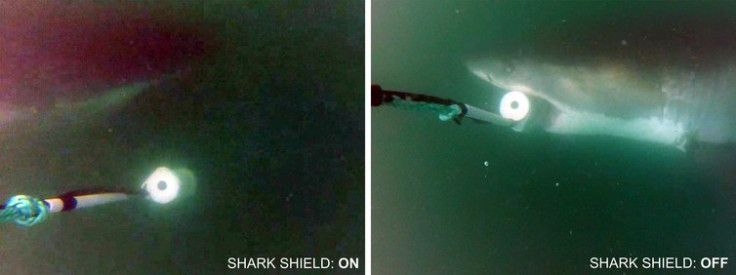Finally, a proven way to keep great white sharks at arm's length
Shark Shield deterred 89% of great whites from approaching bait

Ryan Kempster, University of Western Australia and Shaun Collin, University of Western Australia
A wearable electric shark deterrent can effectively repel great white sharks, according to our independent tests of the device.
The manufacturers of the A$749 Shark Shield Freedom 7TM say it works by emitting an electric field around the wearer. This causes uncomfortable muscle spasms in sharks that swim too close and discourages them from coming into contact.
Our research, published in the journal PLoS ONE, shows that the device does indeed make sharks keep their distance. Upon first encounter with a Shark Shield, all approaching great white sharks were effectively deterred, staying an average of 1.3m away from a baited canister with the device attached.
After multiple approaches, individual great white sharks showed signs of habituation to the Shark Shield, coming an average of 12cm closer on each successive approach. Despite this increase in tolerance, 89% of white sharks continued to be deterred from biting or interacting with the bait.
Don't take the bait
We carried out our testing in Mossel Bay, South Africa, in 2014. We used custom-built cameras equipped with bait and either an inactive (control) or active Shark Shield. Using a video analysis technique traditionally used to measure the size of fish, we were able to determine exactly how closely the sharks approached the device.
We analysed a total of 322 encounters involving 41 individual white sharks, ranging from 2m to 4m long.
Only one great white shark came into contact with the bait in the presence of an active Shark Shield, and only after multiple approaches. The interaction in question simply involved a bump of the bait canister rather than a full bite. In contrast, bites were common during control trials.

Although the effectiveness of the Shark Shield probably varies between shark species, it is encouraging to note its effect on great white sharks, the species implicated in the majority of fatal incidents worldwide. This suggests it could be an important safety consideration for a range of ocean users such as surfers, divers, spear fishers and open-water swimmers.
We also found no evidence that the Shark Shield attracted sharks from further away, which is a common myth among surfers.
A useful tool
Besides showing that the Shark Shield can ward off sharks, our method provides an accurate way to test the effectiveness of any type of shark deterrent that is currently available or likely to enter the market.
But, most importantly for now, we have finally given the public some evidence that there is an effective way to reduce the risk of a negative encounter with a shark.
Instead of the redundant debate about culling sharks as a response to shark-bite incidents, ocean-goers can now proactively take extra precautions, by using proven technology to reduce their already very low risk of injury.

There are many shark deterrent devices on the market, particularly those that use electric or magnetic fields. But without robust, independent scientific evaluation we can't be sure which of these products actually work. In fact, not only may some devices not be as effective as others, but it is also possible that some of them could actually attract sharks rather than repel them.
Robust scientific evaluation of these types of devices will help the public make informed decisions about how they can reduce their risk of encountering a shark.
It's important to note that the likelihood of being involved in a negative encounter with a shark is exceptionally low. As a result, some will argue that the use of expensive technology to mitigate that risk even further is unnecessary. Furthermore, no device is likely to guarantee 100% protection from any species of shark.
But at present, under the conditions in which we tested it, this is one device that does seem to offer a genuine benefit. So if you feel that you need extra protection from sharks when entering the water, this device will offer you exactly that.
This article was written with the help of Channing Egeberg, a University of Western Australia marine euroecology MSc graduate and cofounder of Support our Sharks.
Ryan Kempster, Shark biologist, University of Western Australia and Shaun Collin, Winthrop Professor/WA Premier's Research Fellow, School of Animal Biology and the Oceans Institute, University of Western Australia
This article was originally published on The Conversation. Read the original article.
© Copyright IBTimes 2025. All rights reserved.





















